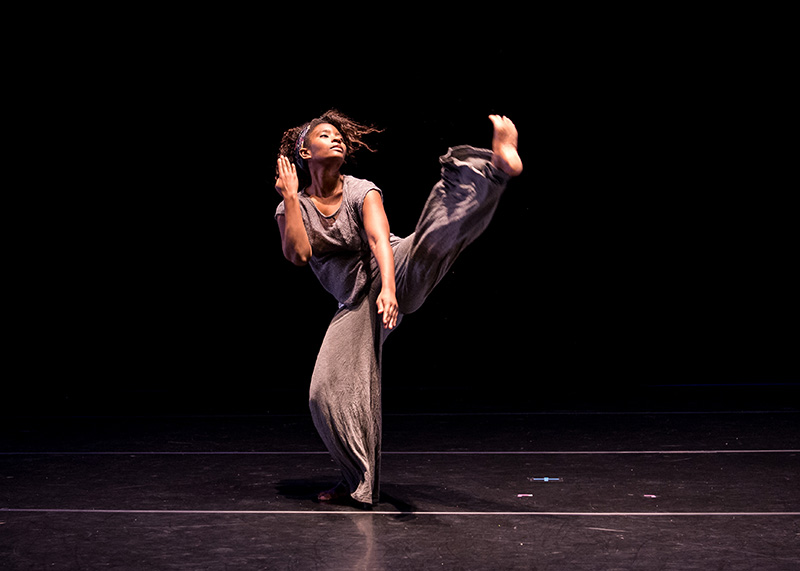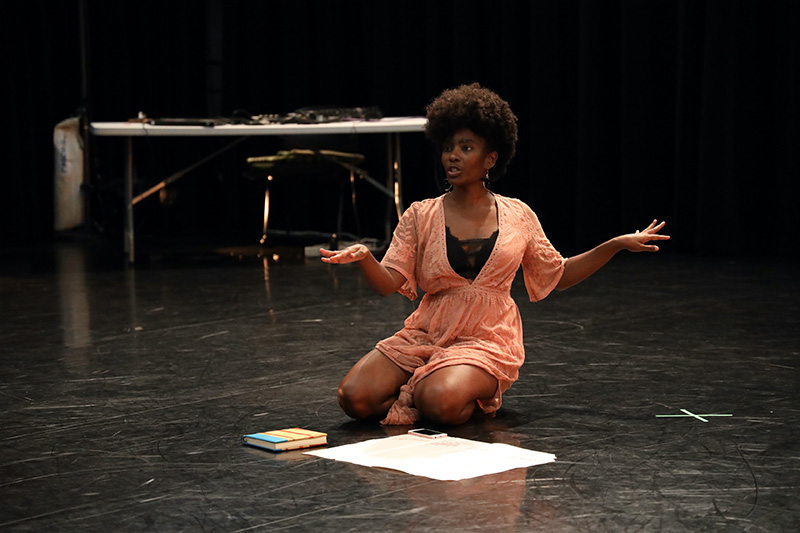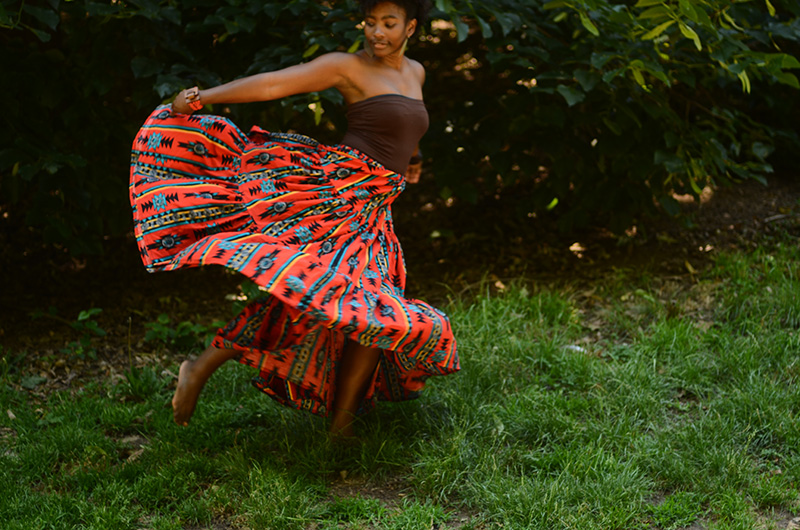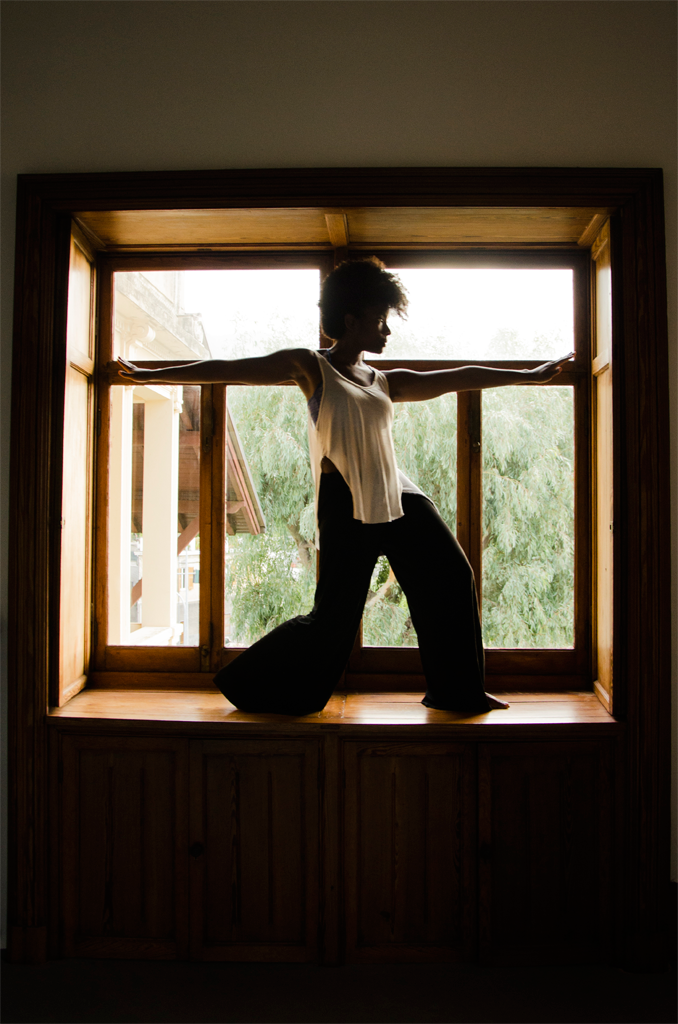Perceiving and Being Perceived
An Interview with Melanie Greene
BY EMMALY WIEDERHOLT
Melanie Greene is a dancer, choreographer, writer, and podcaster currently based in New Orleans. In addition to her own work, she has written about dance extensively as well as co-hosted the podcast The Dance Union. Here she discusses her recent Sapphire project that explores the Black female experience through an Afro-futuristic lens, as well as the intersections of her performance and journalistic experiences.

Photo by Ian Douglas
~~
Can you share a little about your dance history? What kinds of performance practices and in what contexts shaped who you are today?
My dance history began in 9th grade in public high school where dance was offered as a free program. Otherwise, I don’t know if I would have had the opportunity to pursue dance. It was a modern dance class in rural North Carolina. Some would say I started late, but I feel like I started right on time.
American Dance Festival came across my consciousness. I didn’t go because my parents could not afford it, but I did go to North Carolina School of the Arts for a summer intensive because my teacher, parents, and community raised the funds. Because I had so much community support, it encouraged me to keep going and continue to let them know what I’m doing. Their investment is still thriving.
When I went to college, I wanted to pursue dance, but my parents asked me to study something more marketable, so I studied Journalism and Mass Communication with a concentration in Advertising and worked in advertising for a while. That was soul sucking for me. I would go into the bathroom and dance. I left that field to get my master’s in Dance at UNC Greensboro. Once I finished my MFA, I decided to go to New York because all my professors in my program had spent time in New York. I thought it was time.
My goal for moving to New York was to continue to push my work and the ways I make work. The master’s program gave me a scaffolding for how to make work, and then in New York I realized that other choreographers weren’t listening to any of those rules and were throwing everything out the window. I wanted to start creating within a new consciousness and new way of being. New York pushed me to do that. I was in New York for seven years, and then I moved to New Orleans in 2020.
New Orleans is a unique space. I’ve been coming back and forth since 2017 to test the waters. The access to resources is different. It gives me a southern vibe with cultural vibrations like New York. My training in New York and the perspective I gained on arts and culture advocacy and policy work is funneling here and helping me understand the landscape and history better so that I can understand what’s possible for my work here.

Photo courtesy the Maggie Allesee National Center for Choreography
What was the impetus behind your Sapphire project?
When I moved to New York, I jumped into the downtown dance scene. I was seeing a lot of immersive and experimental dance with naked white women. Coming from North Carolina and a religious background, I wondered, “What’s going on here?!” And then I started to wonder, “Where are the women of color?” There was such freedom, audacity, and confidence. I wanted to know: Where are the women who look like me making this work? I started to do some research and dove into the history of Black women in the downtown dance scene. I shared my research at the CADD conference at Duke University about nudity as costume. One crucial piece of feedback I got was that neutrality (arguably achieved by these white artists during a durational state of performance) can never be afforded Black women. Accepting this truth was an invitation to explore the history of Black female representation in pop culture and different dance spaces, and if I wanted to explore this, I wondered: How could I do this safely, responsibly, and respectfully? That’s how Sapphire came about. She was a way of exploring the idea and expanding my lens. As a character from the future, she offers a nuanced way of asking why, what, and where this representation happens from a perspective of knowing and unknowing. She is our future; we are her past. In wanting to explore forms of nudity, the gold paint became a way for me to feel protected and safe. It became armor and a way for me to transform into being this curious warrior from the future looking at the past, which is our present. The more I performed the work, the gold paint begin to evolve into additional meanings.
What was the choreographic process behind both the performance and the film?
I call it the Sapphire Universe because there are actually three components. I’ve been working on it since 2016. The performance is live and in conversation both with the people in the space and the location where it’s happening. I did it recently in New Orleans and had a very different conversation than when I did it at Judson Church in New York. Another component of the universe is the three graphic novels. They are non-linear short stories about Sapphire. It’s a literary way of getting into the world of the character. Every aspect of the graphic novels was touched by a moving practitioner; the cover, illustrations, book design, even the editing was by a dancer. And now I am in the film world. It was interesting to ask, “How does this character exist differently in different mediums?” Say someone comes into the Sapphire Universe by the stories and then later sees the performance or the film. How does coming into the film inform the experience of Sapphire? They each add an element to the ongoing story but don’t tell the same story again. Every time I perform it, I get new information or new insights. As long as it continues to feed me, I’ll continue to explore different aspects of Sapphire.
I performed it last September in New Orleans. When Sapphire births herself, she wears this crochet netting. And at the end of the journey, she’s on the floor crocheting. My friend who came to the show thought Sapphire was crocheting her costume from the beginning. What an interesting time-travelling interpretation – crocheting something in the future of a piece that’s meant for the past of a piece. Actually, what I was crocheting was a baby blanket to speak to the evolution of this world. Even something as simple as this audience insight gives me fuel: What if I take this idea in a new direction?
Sapphire is still very active and informing. I project it will be done in 2025. I feel like I should wrap her up, but I want to be truthful: Is this passion still mine? Is there still a community and audience for this?

Photo by Larry Rosalez
I’d like to shift gears. You have also worked as a dance writer and podcaster. How did you get involved in writing about dance?
I did a summer after grad school at American Dance Festival as a teaching assistant. I had the opportunity to watch all these amazing performances. I wanted to capture and archive it. When I moved to New York, I continued to write. One of the things that fueled me in the beginning was there are so many works not being archived and folks not being covered. I started going to shows where there wasn’t a lot of coverage and being intentional about sharing those stories. Some of the pushback I got was that I didn’t give my opinion about the success of a piece. For me, it wasn’t about my opinion but rather about archiving what took place so a reader could decide if it was something they would have liked or have questions about.
Did your podcasting with The Dance Union Podcast flow from your dance writing, or was it separate?
The Dance Union Podcast was separate from my writing. I wanted to talk about our industry. J Bouey started The Dance Union Podcast. We met during a residency at Gibney. I was interested in doing a podcast too, so I asked J if I could sit in on their podcast and observe how they are managed. I intended to just sit in the background and observe, but then I ended up talking for most of it. J invited me to come back. That’s how our duet emerged and continued for several years with the podcast.
It seemed like The Dance Union Podcast hit a certain zeitgeist during the pandemic.
Originally it was just to talk about things happening in the field. During the pandemic, we happened to be at the right place at the right time. I learned it’s important to notice all the sparks but be prepared for the flame.
How has your experience as a journalist influenced your artistic practice and vice versa?
It doesn’t feel connected, but I know that it is. My relationships are shifting. I’m still figuring it out. How my journalism and podcasting and artistic practice are all connected is hard for me to see right now. Sometimes they felt like separate hats.
Now I’m in an exploratory phase. I’m teaching a course at a university this semester called Embodied Writing that asks how being in an embodied movement space informs writing. How do these two disciplines become more intertwined? I’m sure all the experiences I’ve gained over the years have given me the inspiration and courage to try this and invite people on the ride. I appreciate this question because it’s an invitation for me to see how they’ve always been in conversation, never in silos, and how I can nurture that.
Anything else you’d like to share?
I have so many ideas for projects assuming funding. This whole component of funding in our industry… I want to find more sustainable continuous models for supporting work instead of crowdsourcing or applying for grants. A lot of things are brewing.

Photo courtesy the Bogliasco Foundation
~~
To learn more about Melanie’s work, visit www.methodsofperception.com.

Leave a Reply